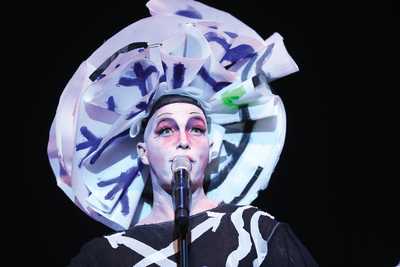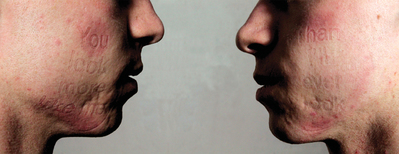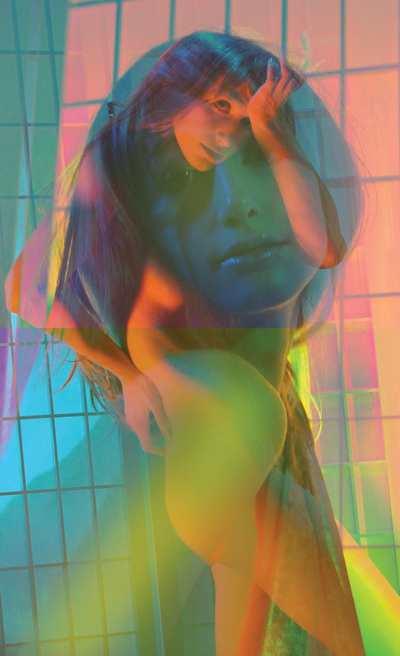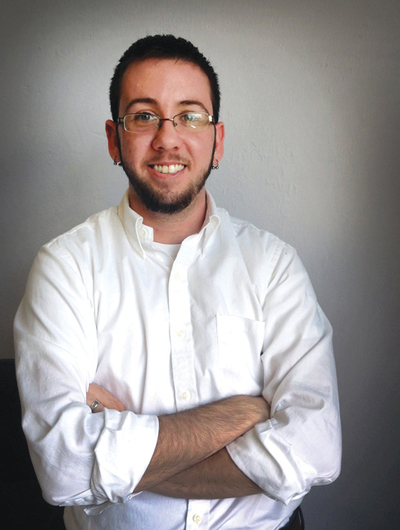Turning Barriers into Bridges

Taylor Mac in A 24-Decade History of Popular Music: 1770s-1790s, Hopkins Center for the Arts, Dartmouth College, 2015, photo credit Rob Strong.
A story about power
When 23-year old Elijah posted photographs on Facebook in 2014, the last person he expected to hear from was his mother. Family communication had been strained ever since Elijah came out as transgender. But he had modeled for “Gender, Projected”—a photography series by New Haven, CT, artists Am Norgren and Reese Ramponi—and proudly shared the results. His mother noticed the portraits and was moved to make contact; before long she, too, was modeling for Norgren and Ramponi, and mother and child began building a stronger, more genuine relationship. “Without Gender, Projected,” Elijah writes, “I don’t know how long it would have taken for us to understand each other.”
This is an article about power: the power of the image, the power of language, the power within the vulnerability of performance. The “strange power” of art, to paraphrase critic John Berger, that unites people through commonalities rather than differences. And the strength found in celebrating our differences by shining light on the complexities of human experience. In other words, art’s potent ability to fight prejudices and rebuild barriers into bridges. Here we consider artists, educators, organizers, curators, subjects, grantmakers, and audiences in New England who belong to or support transgender and gender non-conforming communities. Their work reaches across divides.
Mainstream Narratives, Human Rights Crisis
More and more, trans stories—narratives connected to people who do not conform to conventional notions of gender as a biologically defined state—are making their way into mainstream consciousness. There is growing visibility in the fashion industry as trans models work runways and ad campaigns. Transgender characters are increasingly featured in film and on television—although more investment needs to be made in trans producers, writers, and directors. Celebrities like Laverne Cox and Caitlyn Jenner have become household names, breaking social media records and gracing the covers of Time and Vanity Fair.
This marks an evolution from overwhelmingly negative past representations of trans identities. But the road ahead is still long. Despite heightened prominence in the media, this is a time of human and civil rights crisis in daily life. The most recent study conducted by the National Gay and Lesbian Task Force and the National Center for Transgender Equality in 2011 surveyed over 6,000 transgender and gender non-conforming participants nationwide. The findings are staggering: 63% of participants had been victims of a serious act of discrimination—events that seriously impact quality of life and emotional and financial health, including physical and sexual assault, harassment, eviction, homelessness, loss of employment, denial of medical services, and significant family rejection; 23% experienced at least three of these major life disrupting events; 41% had attempted suicide, compared to 1.6% of the general population.
Across New England, 91% of the 2011 study’s 540 respondents reported mistreatment at their jobs, 81% reported harassment while in school, 15% were refused medical care due to gender expression, and 67% had been mistreated in public. In 2014, the Fenway Institute and the Massachusetts Transgender Political Coalition (MTPC) released the study Project VOICE, which found that nearly two-thirds of transgender Massachusetts residents experienced discrimination in a public accommodation last year.
A 2015 study is underway to update these numbers, and although rights have been improving overall for trans Americans, anecdotal evidence and news coverage still paint a painful picture. Transgender women of color, in particular, continue to be the victims of ongoing violence at distressingly high levels.

James Helenski, 6 minutes, 60 pounds (I and II), archival print on plantain rag, 2015.
Safe Spaces for Creative Freedom
In the words of Mason Dunn, executive director of the MTPC, “Visibility in all types of art and media can be extremely powerful to promote kindness, compassion, and understanding.” It’s one way that we can work toward eliminating harassment of transgender and gender non-conforming people and reach a common ground when gender expression is just one of an individual’s many traits. However, participation in the arts is not a right that every New Englander freely enjoys. It might surprise some to learn that there are limited legal protections for trans people in public accommodations in Massachusetts and New Hampshire, compared to other New England states.
Massachusetts’s Gender Identity Nondiscrimination Act, passed in 2011, does not cover spaces like hotels, restaurants, public parks, buses, trains, hospitals, theatres, and museums. It goes without saying that this limits trans people from safely accessing art; therefore diminishing artists’ opportunities for their work to be seen, contemplated, appreciated; therefore squashing dialogue and further creation. The issue is cyclical. The MTPC is currently working on the Freedom Massachusetts bill to address gender discrimination in public spaces, to be heard in early November of this year.
On furthering understanding and empathy, professor, author, and national advocate Jennifer Boylan notes that “the key, as always, is telling stories in a public way.” Enclosed are just a few examples of the stories being told through dynamic New England art.
Transformative Images and Words
“My hope is to raise visibility and create a sense of community by bringing people together,” says Dylan Hurwitz, artist, activist, and director of the Boston LGBTQIA Artists Alliance (BLAA), an organization 70 members strong. He elaborates that the wide range of backgrounds of BLAA’s artists is exactly what makes the collective so exciting. While the Alliance recently lost permanent exhibition space, they continue to organize shows by holding “pop up” events in galleries throughout Boston. At the time of print, BLAA is working with Samsøñ, a gallery in Boston’s SOWA district, to present Makeover!, a group show exploring transformation, metamorphosis, and shaping and updating the self, challenging the negative implications of unrealistic beauty standards and normative gender expression.
Makeover! includes artists like Geena Matuson, a multi-media innovator whose surreal work layers the body, overlapping one figure with the next to create fractured prisms. Matuson’s practice often explores genderless and dual-gender characters. “Duality and impermanence are heavy themes in my work, however light I try to make of it,” she writes, noting that she was raised androgynous and subject to male and female roles growing up. “Creating art with a strong commentary on gender roles is, I believe, the first step in combatting negativity.”
While Matuson’s self-portraits shimmer with candy-colored iridescence, those of James Helenski throb with corporeality. Helenski utilizes their own body as a canvas; photographs display red welted letters pressed into the artist’s skin, phrases from an original spoken word piece about the oppressive power of language called “I Hear Your Words.” Helenski carves crisply legible woodblocks and invites collaborators to apply them with pressure to the artist’s body, creating a conversation rather than a self-inflicted idea. Photographs of these private happenings are titled after specific weights and durations. They challenge the pain that language can cause, in order to make visible the feeling of being trans in a cisgendered society; their rawness touches the nerves of any viewer. “What I seek to do,” writes Helenski, “is not rebuild a way of thinking from the broken pieces of the previous dominant culture, but to radicalize daily interactions so as to create new space beyond our current ways of thinking and living.”
Elsewhere in Boston, performance poet Ethan Smith explores language’s potency in his own way. Smith started writing and performing in his teens and came out onstage as an undergrad at Berklee College of Music. His gripping and emotional “Letter to the Girl I Used to Be” has been shared by outlets from Button Poetry to Seventeen and praised by critics and readers around the world. “Every time I out myself on stage, I create a political situation by being who I am,” Smith muses. “By speaking as our whole and honest selves, we are able to spark important dialogue off stage.” He notes that through the vulnerable act of performing poetry on stage, artistry is found by being clear.

Geena Matuson, Neon Opalescence, archival inkjet print, 2015.
Different Sets of Eyes
The New England Foundation for the Arts (NEFA) is committed to funding projects that reflect diversity and examine identity. Program manager Adrienne Petrillo notes that art “lets us glimpse the world through different sets of eyes, and makes us all more empathetic, understanding, and willing to get to know other people.” One recent example is the work of gender-twisting theater artist Taylor Mac, whom NEFA has sponsored to present three New England engagements as part of his epic 24-Decade History of Popular Music, a blend of mythology and musical spectacle currently in development. The project’s New England leg began in June at the International Festival of Arts & Ideas, where Mac premiered an interactive concert on songs and politics of 1990s radical lesbians. This September, he presented a piece at Dartmouth College’s Hopkins Center for the Arts on the music of 1776–1806, the founding era of both Dartmouth and its hometown Hanover, NH. In order to inform the elaborate costumes and narratives that flavor the show, Mac researched colonial churches and museums in New Hampshire and Vermont, looking for “the little nuggets that you won’t find in high school history books.” He forged connections between historical societies and queer alliances, engaging a diverse mix of people—young, old, campus, community, straight, queer, artist, and historian—around personal definitions of revolution. “I want people to feel confused, enticed, and disturbed,” he explains. “Seeing things we don’t understand leads to asking questions and learning.” Taylor will stage the third NEFA-funded performance at Williams College in February.
Cranston, RI, based photographer Kevin J. Briggs also aims to spark questions. With his black-and-white photography series Stereotypes: A Conscious Look at Race, Faith, Gender, and Sexual Orientation, Briggs hopes to awaken viewers’ minds to their own biases. Each silver gelatin print features a subject—“WOMAN,” “LATINO,” “TRANSGENDER,” staring calmly at the spectator behind projections of derogatory slurs covering their faces and bodies. The effect is jarring; one strains to make eye contact with the person behind the barrage of hateful words.
Dialogue between the artist and his subjects centered on two-way sharing of their backgrounds, their lines of work, and their personal stories related to prejudice. When Briggs exhibited these portraits earlier this year at Gallery Seven in Maynard, MA, each was displayed alongside the subject’s name, profession, and personal statement, and gallery visitors were encouraged to complete a questionnaire about their emotional reactions to the work. Briggs noted that curiosity, guilt, and anger surfaced, and believes the experience to have been cathartic for everyone involved. “You can come to grips with your own fears, overcome them, and grow from the experience,” he says, “and that’s the response I received from subjects and
viewers alike.”
Reclaiming and Reframing
Enlisting the talents of Providence, RI, artist J.R. Uretsky as a guest curator at Artspace in New Haven, CT, will open hello, world! this December. An exploration of how queer identity can function as a projection of self while resisting and reframing normative definitions, the exhibition is curated with an eye toward a wide range of experiences—the complex, the painful, the humorous, and the deeply personal—and aims to fuel conversation around identity. “The artists I’ve selected are showing us that they are here,” Uretsky reflects. “And they are doing so, not with sparkling frills and sex (as queer artists often get stereotyped using), but rather by showing their invisibility: the unseen, the inner life, the quiet song of the queer. I am here, do not erase me.”
Among featured projects is Boston-based Nabeela Vega’s “Adventures of Thahab” video series. Thahab is a sparkling gold ghost character, simultaneously a Halloween specter, a nonsexualized covering, and an echo of a burka. Playing with the idea of terror and terrorism, the Muslim artist places this covering on their body or other’s bodies and moves through natural settings and public spaces (beach, supermarket, Domino’s pizza chain), acting calm and collected while recording the confused, and sometimes hostile, reactions of others.
Continuing the theme of identity politics, Artspace featured “Gender, Projected: Exploring Gender and Identity Through Photography and Dialogue” as part of their City Wide Open Studios celebration this October. To date, artist couple Am Norgren and Reese Ramponi has worked with more than 50 subjects—as in Briggs’ project, non-professional models—including Elijah mentioned in this article’s opening. Models represent diverse ages, races, sexualities, and gender identities. They use their own wardrobes to dress in fluctuating gender expressions: masculine, feminine, and many points in between. Each was photographed in multiple poses against a white background, and then interviewed about how they feel in different outfits and stances. The results demystify stereotypes by recognizing the gender identities we all perform, every day. “The power of the image,” says Norgren, “is for when words just aren’t enough.”

Am Norgren and Reese Ramponi, Jonathan, from Gender, Projected, photograph printed on Sintra board, 2015.
Our Region, Our Future
Many stories are being told in New England; more still are not. What can be done to create safe, creative platforms for those unheard voices? Input varies across cities and experiences. Norgren, who is originally from Arizona and going on their third year in Connecticut, notes that New England has been phenomenally supportive of their practice.
“People here have been very direct, very forward. In the beginning, our subjects were our friends: mostly white people between 20 and 30 years old. Audiences in this region were very direct about the need for diversity and willing to have an open dialogue.” Vega shares a different point of view. “Boston does not have a reputation for being supportive of queer aesthetics and lifestyles. The lack of visibility and support, especially for black and people of color queer folks, in media is exactly why [fellow artist] Anum Awan and I began our project A Future of Radical Queer Possibilities. While there seems to be a flirtation with social justice and movement making for artists, our creative community needs to be making more of a commitment…change takes time, learning, and patience.”
Beyond improving legislation and creating spaces for inclusion, outreach to young people is critical for change. Depression, alienation, confusion, and separation from families are all too frequent for transgender youth, especially in non-white households. Youth organizations such as Lgbtq+ Youth Kickback, run by the People’s Arts Collective in New Haven, are working hard to help kids build community and develop leadership. Jai, a Kickback participant and Hartford Art School freshman, speaks confidently of coming into their own as an artist, an activist, and a gender non-conforming individual. “To make art that comments on or challenges oppressive systems is dangerous,” they write. “You have to be accountable for everyone you move with that art. It is like giving people fire: if you don’t teach them how to use it, that’s just plain irresponsible.” Elizabeth Larkin, an organizer who has mentored Jai, adds to these thoughts. “Humans, in encounter with themselves and with one another, have the responsibility to interrogate, to educate, and to convey; perhaps in this way the artist is more deliberately human than others.”
Considering the richness of stories and art shared across our region, and the hopes for a future free of discrimination and prejudice, I return to the wisdom of Jennifer Boylan. “It’s impossible to hate anyone whose story you know,” she says, quoting her mother. “When you put a human face on something through narrative, it becomes familiar. And that is how you change the world.”
Tori Rysz is a New Haven-based writer and a graduate of Sarah Lawrence College. When not writing about art, she can be found working in communications for Yale University.
SIDEBAR:

Mason Dunn. Courtesy of the Massachusetts Transgender Political Coalition.
When I began working in LGBTQ advocacy, now over 10 years ago, positive trans-
visibility was all but nonexistent in media and art. Most representations of trans identities in large media outlets were portrayed with an almost casual transphobic tone, as the butt of some joke, or the source of criminal-minded deception. Furthermore, trans-identified artists were largely unknown, except in our own
community.
Today, much has changed: trans people are on the covers of magazines, making waves in the fashion world, writing, singing, acting, filming, and making art in hundreds of new and exciting ways. Yet, while this explosion of attention and visibility is exciting, I am continuously disappointed by the majority of narratives, and more specifically the sources of these narratives, that garner large-scale attention in the US. While the stories and experiences of trans people are making their way to the larger public, these narratives are often created and/or portrayed by white, cisgender people—they lack the complexity, depth, and beauty that I see everyday in the trans community.
Take, for example, some of the recent films which seek to tell the stories of trans people: written by cisgender people, portrayed by cisgender actors, and speaking only to the most shallow and “consumable” aspects of trans lives, these films (such as “About Ray,” “Stonewall,” and “The Danish Girl,” to name a few) leave much to be desired. Their identities are treated with a sense of inauthenticity, and conveyed through a binary lense that fails to see the nuance and reality of trans experiences.
It is my sincere hope as society around us learns more about transgender identities, artists, writers, and actors will begin to explore the more complex and intersecting identities within this beautiful community. Advocates and artists, working hand-in-hand can make this a reality.
—Mason Dunn
Executive Director of the Massachusetts Transgender Political Coalition
